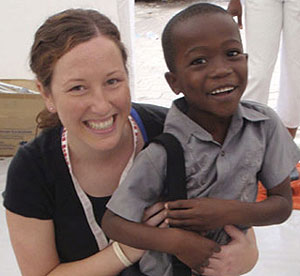 |
| Occupational therapist Melissa Grant was drawn back to Haiti after the earthquake. (Photo courtesy of Melissa Grant) |
The first patient that Gavin Langille saw in Haiti was a teenage girl who had been stabbed in the side, deep enough to pierce her liver.
‚ÄúWe didn‚Äôt have an OR at our clinic ‚Äď we just had a basic table for things like deliveries,‚ÄĚ says the AVĺ„ņ÷≤Ņ surgical resident. ‚ÄúSo we packaged her up as best we could and drove her to the nearest hospital a couple of hours away: two paramedics from Oregon and I, in the back of a pickup truck, sitting by her side as she got worse and worse.‚ÄĚ
It was a month after the 7.0 magnitude earthquake had devastated the Latin American island. Dr. Langille arrived in Haiti on short-notice; he had only 24 hours to find colleagues to cover his hospital shifts and get to Montreal to join a medical contingent about to depart. But he couldn‚Äôt pass up the opportunity to make a difference. Over the next five days at a makeshift clinic in Petit-Go√Ęve, 70 km west of Port-au-Prince, the team would attend to 300 patients a day dealing with everything from typhoid fever and malaria to long-term physical injuries.
At that moment, though, he was concerned with just one patient. The team succeeded in getting the young girl to a hospital for her wounds to be treated. The next day, Dr. Langille returned to the same hospital with another patient and was able to learn that the girl had survived the night after an operation to control the bleeding. That sort of follow-up, though, was a rare opportunity.
'You wanted to do more'
‚ÄúAs doctors, we like to succeed, to feel like we‚Äôre following things through to the end, but down there we were just temporizing things,‚ÄĚ he recalls. ‚ÄúMinute-to-minute, you weren‚Äôt satisfied ‚Äď you wanted to do more.
‚ÄúThat said, we knew that if our team wasn‚Äôt there, if we didn‚Äôt have the extra people with us, the patients could have been doing a lot worse.‚ÄĚ
When the Haitian earthquake hit on January 12, it left a catastrophic wave of devastation: 230,000 dead, 300,000 injured, and over a million homeless. Even for organizations like the Red Cross with extensive disaster experience, the scale was enormous.
‚ÄúPart of it is that there was already a lack of infrastructure in the country, a void of government support,‚ÄĚ says Ismael Aquino (BSc‚Äô92, BN‚Äô96), regional director for Atlantic Canada with the Canadian Red Cross. ‚ÄúIt was also largely an urban disaster, and that complicates things. As well, getting into Port-au-Prince is a challenge with only one small airport that‚Äôs not used to having that much activity.‚ÄĚ
Team Canada Healing Hands, a not-for-profit providing rehabilitative education, training and care, has had a presence in Haiti for seven years. In the aftermath of the quake, the organization has been sending teams to provide support to field hospitals and, in more recent months, encourage long-term planning and sustainable rehabilitation programming. For those who had been to Haiti before, like occupational therapist Melissa Grant (BSc OT’07), it was difficult to find the words for what they saw.
‚ÄúYou would see a family eating their lunch on the collapsed roof of their former home, a woman trying to find privacy as she bathed from a bucket, and children sifting through the rubble,‚ÄĚ she says, reflecting on her trip to Haiti this March. ‚ÄúIt was so overwhelming that you couldn‚Äôt help but become emotional.‚ÄĚ
Needs are enormous
Ruth Duggan (BSc OT’88, MSc OT’02), a longtime volunteer with Team Canada Healing Hands, was able to travel to Haiti through an organization called Handicap International only two weeks after the earthquake to start assessing rehabilitation needs. She is already planning her return trip later this year.
‚ÄúThe rehab needs are enormous,‚ÄĚ says the Halifax-based occupational therapist. ‚ÄúBefore the earthquake there were some 800,000 people with disabilities. Now we add on top of that the new people with amputations, spinal cord injuries, brain injuries, orthopedic injuries ‚Ķ that‚Äôs another 200,000 people. In a country that only has a population of nine million, that‚Äôs a staggering number.‚ÄĚ
Concerns such as these are only going to be amplified in the months ahead as the country faces the arrival of the rainy season. Yet, aid workers share a confidence that, in the long run, the future of Haiti is cause for optimism as they work with the Haitian people to build capacity and infrastructure for the future.
‚ÄúThere is better medical care in place there now than for as long as I‚Äôve been going there,‚ÄĚ says Ms. Duggan. ‚ÄúI hope that they‚Äôre going to start rebuilding roads, they‚Äôre going to start rebuilding the infrastructure, and they‚Äôre actually going to do it in a way that‚Äôs better. I think it‚Äôs going to have a long-lasting effect.‚ÄĚ
Mr. Ismael agrees, using the Halifax Explosion as a historical analogy. Prior to the explosion, Halifax was ridden with poverty, but the disaster brought the best engineers to the city to rebuild it anew.
‚ÄúHalifax wouldn‚Äôt be the city it is today without the explosion,‚ÄĚ he says. ‚ÄúSometimes a disaster represents an opportunity. It gives me hope that Haiti will be able to emerge stronger than ever before.‚ÄĚ
